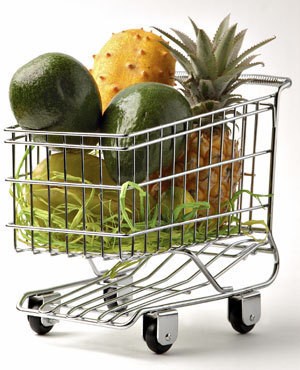 I'm often asked if the fruits and vegetables purchased from a grocery store can be planted to produce more food. The answer is, yes! And not only can you plant fruits and vegetables, but nuts and spices, too. As with traditional gardening, the key to successful "grocery store gardening" is to keep an open mind and possess a willingness to experiment. And above all, have fun!
I'm often asked if the fruits and vegetables purchased from a grocery store can be planted to produce more food. The answer is, yes! And not only can you plant fruits and vegetables, but nuts and spices, too. As with traditional gardening, the key to successful "grocery store gardening" is to keep an open mind and possess a willingness to experiment. And above all, have fun!
Coffee beans (non-roasted), tomatoes, wheat, rye, oats, lemon grass, taro, potatoes, green onions, garlic, pineapple, sunflowers, water chestnuts, popcorn, and raw spices (fennel, anise, sesame seed, celery seeds, etc.). In the case of peppers, squash, pumpkins, cucumbers and eggplants, the seeds need to mature along with the fruit, so look for ripe or even overripe produce to use as seed stock.
This page contains the following solutions.
We usually don't think of hot house tomatoes as being as good as those grown in an open garden, and in the past, that was true. It's different, now.
The following five houseplants are worth growing just for the sheer fun of it. All share a few common features - they are obtained from planting seeds, pips, or plant tops from fruits and vegetables you buy for eating.
Here are the questions asked by community members. Read on to see the answers provided by the ThriftyFun community.
Why can I not germinate seeds from store bought fruits and vegetables? Does this mean they were gassed before they got to the store?
By Robin
I do not know what you mean by "gassed". Most grocery store and even farmer's market produce is grown from hybrid seeds. The seeds may not germinate or may revert back to an earlier hybrid plant.
Seeds that are sold for gardens are specifically developed for garden growing and usually do not revert back to earlier hybrids.
Fruits and veggies coming from out of country are radiated lightly to kill off any foreign bacteria or pests that may hitch a ride. Try to buy local to get growables. Did you know you can grow grocery store mushrooms? Its a fun winter project.
I purchased some raspberries from the grocery store. They had a delightful taste and were a great size. Can you plant the seeds to start your own raspberry plants?
By Rolene
I am trying to grow some as we speak. Most fruits might be genitcally altered to not reproduce. I have grown lemon trees,apple, pomegranate, and melon plants from actual fruits though. I would try it and see, what do you have to lose? You might have a better chance if you found berries from a natural bush though. Good luck. I will let you know if myne sprout!
Raspberries grow on canes. Never heard of anyone growing from seed but good luck!
Check this link:
www.gardenaction.co.uk/
I found the instructions of how to plant onions from discarded bottoms. Unfortunately it didn't work for me. I will try again. Has anybody had luck with it?
Ayaoba
step 1
Materials
You will need: onion, clean knife, cutting board, starter pot with potting soil (optional)
step 2
Slice Off Onion Bottom
Chop off the onion bottom with all the roots still intact. The more of a bottom you leave on, the better. Try for 1.5-2 inches of attached "meat". Allow to dry for a few hours to a couple days in a shaded, well-ventilated area to allow for callousing. Note: You might only need a few hours for callousing. If the cut portions are dry to the touch and slightly shriveled
step 3
Potting
Fill the starter pot 2/3 of the way full and compact. Create an indentation in the center to cradle the onion bottom and allow for good soil contact. Cover with 1-2 inches of soil. Water as needed. Note: You can skip the starter pot if you can't be bothered and plant it directly in the ground.
step 4
Finish
Once the onion bottom has developed a few leaves, remove from the pot. Remove old onion scales. Separate plants as needed by slicing between plants and leaving a portion of the roots attached. You may have more than 1 plant develop from a single onion bottom. Replant in a prepared growing bed. Cut leaves down to 1/3 of the size to allow the bulb to develop. good luck.
This page is about growing an avocado from seed. A fun and rewarding indoor project can be starting an avocado pit.